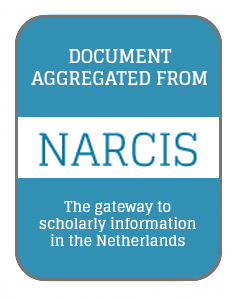Focal point
Location
National Academic Research and Collaborations Information System (NARCIS) is the main Dutch national portal for those looking for information about researchers and their work. NARCIS aggregates data from around 30 institutional repositories. Besides researchers, NARCIS is also used by students, journalists and people working in educational and government institutions as well as the business sector.
NARCIS provides access to scientific information, including (open access) publications from the repositories of all the Dutch universities, KNAW, NWO and a number of research institutes, datasets from some data archives as well as descriptions of research projects, researchers and research institutes.
This means that NARCIS cannot be used as an entry point to access complete overviews of publications of researchers (yet). However, there are more institutions that make all their scientific publications accessible via NARCIS. By doing so, it will become possible to create much more complete publication lists of researchers.
In 2004, the development of NARCIS started as a cooperation project of KNAW Research Information, NWO, VSNU and METIS, as part of the development of services within the DARE programme of SURFfoundation. This project resulted in the NARCIS portal, in which the DAREnet service was incorporated in January 2007. NARCIS has been part of DANS since 2011.
DANS - Data Archiving and Networked Services - is the Netherlands Institute for permanent access to digital research resources. DANS encourages researchers to make their digital research data and related outputs Findable, Accessible, Interoperable and Reusable.
Members:
Resources
Displaying 141 - 145 of 1863Land Use Conflicts in the Energy Transition: Dutch Dilemmas
The transition from fossil to renewable energy needs changes in land use. The development of renewable energy sources introduce extra and sometimes new externalities, such as shadows and noise on landscape. There are governments who are experiencing difficulties when developing renewable energy sources especially when existing land owners (and others) start anticipating on those externalities. Therewith, land use conflicts have become a major issue for governments in meeting renewable energy policy objectives.
Analyses of land cover change trajectories leading to tropical forest loss : Illustrated for the West Kutai and MahakamUlu Districts, East Kalimantan, Indonesia
In Indonesia, land cover change for agriculture and mining is threatening tropical forests, biodiversity and ecosystem services. However, land cover change is highly dynamic and complex and varies over time and space. In this study, we combined Landsat-based land cover (change) mapping, pixel-to-pixel cross tabulations and expert knowledge to analyze land cover change and forest loss in the West Kutai and Mahakam Ulu districts in East Kalimantan from 1990-2009.
Global projections of future cropland expansion to 2050 and direct impacts on biodiversity and carbon storage
Cropland expansion threatens biodiversity by driving habitat loss and impacts carbon storage through loss of biomass and soil carbon (C). There is a growing concern land use change (LUC) to cropland will result in a loss of ecosystem function and various ecosystem services essential for human health and wellbeing. This paper examines projections of future cropland expansion from an integrated assessment model IMAGE 3.0 under a 'business as usual' scenario and the direct impact on both biodiversity and C storage.
Bouwen aan vertrouwen: woningbouwprogrammering aan de vooravond van de omgevingswet : eindrapport PROSPER-onderzoek
How farmers’ characteristics influence spontaneous spreading of stone bunds in the highlands of Ethiopia: a case study in the Girar Jarso woreda
This study aims to identify key differences between farmers who spontaneously implement stone bunds (i.e. farmers implementing stone bunds by their own initiative) and farmers who do not. Data were collected in the Girar Jarso woreda in the central highlands of Ethiopia, through a household survey with 80 farmers: 40 with spontaneously implemented stone bunds and 40 without. Independent samples t test, principal component analysis and regression analysis were used to analyse the data.



